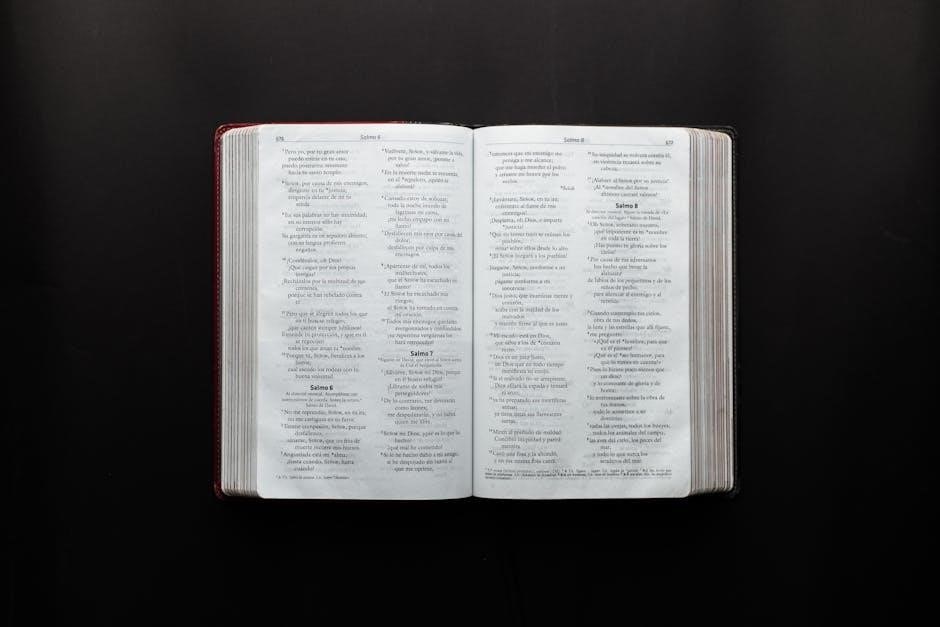An employment reference letter is a formal endorsement of a candidate’s skills and work ethic, crucial for job applications. It provides insights into their professional capabilities and character, helping employers assess suitability. Downloadable PDF samples offer structured templates for various roles, ensuring clarity and professionalism in recommendations.
1.1 What is an Employment Reference Letter?
An employment reference letter is a formal document written by a supervisor, colleague, or client to endorse a candidate’s skills, work ethic, and character; It provides insights into their professional capabilities, achievements, and suitability for a role. Typically requested during job applications, this letter helps employers assess a candidate’s reliability and potential. Available as downloadable PDF samples, reference letters offer structured templates for various industries, ensuring clarity and professionalism in recommendations. They serve as a credible endorsement, enhancing a candidate’s credibility and career prospects.
1.2 Importance of Reference Letters in Job Applications
A reference letter is a critical component of job applications, offering insights into a candidate’s professional capabilities and character. It bridges the gap between a resume and real-world performance, providing employers with a credible endorsement. By highlighting specific skills, achievements, and work ethic, reference letters validate a candidate’s qualifications. They also demonstrate a candidate’s reliability and cultural fit for the role. Employers rely on these letters to make informed hiring decisions, making them indispensable for standing out in competitive job markets. A well-crafted reference letter can significantly enhance a candidate’s chances of securing their desired position.
1.3 When to Use a Reference Letter
A reference letter is typically used during job applications, academic admissions, or business partnerships to vouch for a candidate’s skills and character. Employers often request them to verify previous employment details and assess cultural fit. They are also useful when applying for scholarships, internships, or professional licenses. Additionally, reference letters can be invaluable when transitioning industries or seeking higher roles. It’s best to request them from supervisors or colleagues who can speak to your specific skills and experiences. Having a ready reference letter ensures you’re prepared for opportunities that arise suddenly.

Structure of a Sample Reference Letter
A sample reference letter includes a header, date, recipient address, salutation, body paragraphs, and a closing with a signature. Use PDF templates for a professional format.
2.1 Header and Contact Information
The header of a reference letter should include the writer’s company name, address, and contact information. A date should be placed below the header, followed by the recipient’s address. This section ensures professionalism and clarity. Including the writer’s job title and relationship to the candidate adds credibility. Proper formatting, such as using a business letterhead, enhances the letter’s professionalism. PDF templates often include placeholders for this information, making it easy to customize and maintain a consistent layout. Ensuring all details are accurate and up-to-date is essential for a polished and professional reference letter.
2.2 Salutation and Greeting
The salutation is a polite greeting that addresses the recipient, such as “Dear Hiring Manager” or “To Whom It May Concern.” It sets a professional tone for the letter. In PDF templates, placeholders are often provided for the salutation, making it easy to customize. The greeting should be concise and formal, avoiding overly casual language. If the recipient’s name is known, it should be used to add a personal touch. Proper punctuation, such as a colon or comma, follows the salutation. This section ensures the letter begins respectfully and professionally, aligning with standard business communication practices.
2.3 Body of the Letter
The body of the reference letter provides a detailed overview of the candidate’s qualifications, work ethic, and achievements. It should highlight specific responsibilities, skills, and contributions made during their employment. Including concrete examples of their accomplishments demonstrates credibility. The tone should remain professional and positive, focusing on the candidate’s strengths and suitability for the position. It’s essential to mention the duration of employment and any promotions or recognitions received. This section is crucial as it helps employers assess the candidate’s potential and reliability, making it a cornerstone of the reference letter.
2.4 Closing and Signature
The closing of the reference letter should politely thank the reader for considering the candidate. It may also offer to provide additional information if needed. A professional sign-off, such as “Sincerely,” precedes the writer’s full name, job title, and contact information. The signature section is essential for authenticity, ensuring the letter is credible and traceable. Including a phone number or email address facilitates follow-up communication. A well-crafted closing and signature leave a lasting impression, reinforcing the letter’s professionalism and the writer’s confidence in the candidate.

Key Elements to Include in a Reference Letter
A reference letter should include the candidate’s job title, duration of employment, key responsibilities, and notable achievements. Highlighting specific skills, qualifications, and personal qualities adds credibility. Including contact information for follow-up ensures accessibility, while downloadable PDF templates provide a professional and organized format for presenting these details effectively.
3.1 Job Title and Duration of Employment
Clearly stating the candidate’s job title and duration of employment is essential for providing context. It highlights their role and tenure, demonstrating their experience and commitment. Including specific dates and titles helps employers understand the candidate’s background and responsibilities, adding credibility to the recommendation. This section should be concise but detailed, ensuring the employer can assess the candidate’s qualifications accurately. Downloadable PDF samples often include placeholders for this information, making it easy to customize and professionalize the letter effectively.
3.2 Key Responsibilities and Achievements
Detailing the candidate’s key responsibilities and achievements provides concrete evidence of their capabilities. This section should highlight specific tasks they excelled in, projects they led, and goals they achieved. Quantifiable achievements, such as “increased sales by 20%” or “improved efficiency by 15%,” add credibility. Employers value this information to assess the candidate’s impact and suitability for the role. Including measurable outcomes demonstrates the candidate’s effectiveness and contributions to their previous organization, making the recommendation more persuasive and actionable for hiring managers. This detail is often included in downloadable PDF samples for clarity and professionalism.
3.3 Skills and Qualities of the Candidate
Highlighting the candidate’s skills and qualities is essential to showcase their suitability for the role. Include specific abilities such as communication, teamwork, and problem-solving, supported by examples of how they demonstrated these skills. Mention leadership qualities, adaptability, and work ethic, which reflect their character and reliability. Emphasize their initiative, creativity, and ability to meet deadlines, providing a well-rounded view of their professional and personal attributes. This section helps employers understand the candidate’s potential to contribute effectively, aligning their skills with the job requirements. Referencing downloadable PDF samples ensures a professional and structured presentation of these qualities.
3.4 Contact Information for Follow-Up
Providing clear contact information for follow-up is crucial for employers to verify details or request additional insights. Include the referee’s full name, job title, company name, phone number, and email address. Ensure the information is accurate and professional, avoiding personal or unprofessional details. This demonstrates transparency and cooperation, allowing employers to easily reach out if needed. Including a mailing address is optional but adds credibility. Referencing sample PDF templates ensures proper formatting and completeness of this section, making it easy for employers to connect and confirm the candidate’s qualifications. This step reinforces the letter’s professionalism and reliability.

Sample Reference Letters for Different Scenarios
Explore various sample reference letters tailored for retail, non-profit, and managerial roles. Downloadable PDF templates provide structured examples, ensuring clarity and relevance for different employment scenarios and positions.
4.1 Reference Letter for a Retail Employee
A retail employee reference letter highlights skills like customer service, sales expertise, and teamwork. It should detail the employee’s role in managing inventory, handling cash registers, and assisting customers. The letter should emphasize their ability to work in fast-paced environments and contribute to sales growth. Specific achievements, such as consistently meeting sales targets or receiving positive customer feedback, add credibility. The letter should also mention any leadership roles, like training new staff or overseeing visual displays. Tailoring the letter to the employee’s specific responsibilities ensures a genuine and impactful recommendation.
4.2 Reference Letter for a Non-Profit Employee
A non-profit employee reference letter should emphasize the candidate’s dedication to the organization’s mission and their ability to contribute to community impact. Highlight their role in fundraising, program management, or volunteer coordination, and mention specific achievements, such as successful event planning or donor engagement. The letter should also focus on their collaboration skills, empathy, and ability to work with diverse groups. Including metrics, like the number of people served or funds raised, adds credibility. Tailor the letter to reflect the candidate’s passion for social causes and their commitment to making a difference, ensuring a heartfelt and impactful recommendation.
4.3 Reference Letter for a Manager or Supervisor
A reference letter for a manager or supervisor should highlight leadership skills, decision-making abilities, and team-building expertise. Emphasize their role in guiding staff, achieving organizational goals, and fostering a positive work environment. Mention specific achievements, such as successful project completions or improved team performance metrics. Highlight their ability to motivate employees, resolve conflicts, and adapt to challenges. Include examples of strategic planning and innovation they brought to the role. The letter should convey confidence in their leadership capabilities and their potential to excel in a managerial position elsewhere, reinforcing their value as a supervisor and mentor.

How to Write a Reference Letter
Writing a reference letter involves including the candidate’s job title, duration of employment, key skills, and achievements. Use professional language and provide specific examples of their contributions. Ensure the letter is concise and tailored to the job they’re applying for, highlighting their strengths and qualifications. Always include your contact information for follow-up and maintain a formal tone throughout the document. Utilize downloadable PDF templates for structure and guidance to ensure clarity and professionalism in your recommendation.
5.1 Step-by-Step Guide to Writing a Reference Letter
To write a reference letter, start with your contact information and the date. Address the recipient formally, stating your relationship with the candidate. In the body, mention the candidate’s job title, duration of employment, and key responsibilities. Highlight their achievements, skills, and qualities relevant to the job. Include specific examples to demonstrate their capabilities. Conclude by expressing confidence in their suitability for the position and offer contact details for further inquiries. Proofread for clarity and professionalism, ensuring the letter aligns with the job description and showcases the candidate’s strengths effectively.
5.2 Tips for Making Your Reference Letter Stand Out
To make your reference letter stand out, be specific about the candidate’s achievements and qualities. Avoid generic statements by including quantifiable accomplishments and personal anecdotes. Use active voice to convey confidence and clarity. Tailor the letter to the job description, emphasizing relevant skills and experiences. Maintain a professional tone while showcasing enthusiasm for the candidate. Ensure the letter is concise, well-structured, and free of errors. Highlighting unique strengths and providing context for their contributions will make the letter memorable and impactful for hiring managers.

Employment Reference Letter Templates
Employment reference letter templates are readily available in PDF, Word, and Google Docs formats. They provide structured layouts for various roles, ensuring professionalism and ease of customization.
6.1 Downloadable PDF Templates
Downloadable PDF templates for employment reference letters offer a convenient and professional way to draft recommendations. These templates are pre-designed with standard formats, allowing users to easily customize content. They cater to various professions, including retail, non-profit, and managerial roles, ensuring relevance and specificity. Many templates are free and editable, enabling quick personalization. They often include sections for job titles, durations, key responsibilities, and contact information. PDF templates are ideal for maintaining a consistent and polished appearance, making it easier to present a compelling reference letter. They save time and ensure clarity, helping recommenders highlight the candidate’s strengths effectively.

6.2 Customizable Word and Google Docs Templates
Customizable Word and Google Docs templates for employment reference letters provide flexibility and ease of use. These templates can be tailored to specific job roles, allowing recommenders to highlight relevant skills and experiences. They include editable fields for job titles, durations, responsibilities, and achievements, ensuring a personalized touch. Available in various formats, these templates are ideal for creating professional and polished reference letters. Users can easily modify the content to suit the candidate’s profile, making the recommendation process efficient and straightforward. These templates are perfect for those who prefer a more interactive and adaptable approach to drafting reference letters.

Common Mistakes to Avoid in Reference Letters
Avoid common mistakes like being too vague or generic, failing to provide specific examples, or including unnecessary details. Ensure clarity, professionalism, and relevance to the candidate’s qualifications.
7.1 Being Too Vague or Generic
Being too vague or generic in a reference letter can diminish its impact. Avoid using broad, non-specific language that fails to highlight the candidate’s unique qualities or achievements. Instead, provide concrete examples of their skills, accomplishments, and contributions. Vague statements, such as “they were a good employee,” lack depth and credibility. Employers seek detailed insights to assess suitability, so ensure the letter is specific and tailored to the candidate’s strengths. Overly general letters may lead to skepticism or disinterest, undermining the candidate’s chances. Clarity and specificity are essential for a compelling recommendation.
7.2 Including Unnecessary Information
Including unnecessary information in a reference letter can detract from its professionalism and clarity. Avoid mentioning unrelated personal details, anecdotal stories, or opinions that don’t pertain to the candidate’s qualifications. For example, discussing their family life or hobbies unrelated to the job can be inappropriate. Similarly, overly casual language or jokes can undermine the letter’s credibility. Stick to relevant details about the candidate’s skills, work ethic, and achievements. Ensure the letter remains focused, concise, and directly tied to the candidate’s professional abilities. Unnecessary information can confuse or distract the reader, reducing the letter’s effectiveness in supporting the candidate.

Personalizing Your Reference Letter
Personalizing a reference letter involves tailoring it to the job description and highlighting the candidate’s relevant skills and experiences. This ensures the letter stands out and meets the employer’s specific needs.
8.1 Tailoring the Letter to the Job Description
Tailoring a reference letter to the job description ensures relevance and impact. Start by aligning the candidate’s skills and experiences with the job requirements. Use specific keywords from the job posting to highlight relevant responsibilities and achievements. For example, if the job emphasizes teamwork, mention the candidate’s collaborative projects. If leadership is key, focus on their managerial roles. Including measurable outcomes, like “increased sales by 20%,” adds credibility. Customize the tone to match the employer’s industry, whether formal or casual. Finally, ensure the letter addresses the employer’s needs directly, making it clear why the candidate is the best fit for the role.
8.2 Highlighting Relevant Skills and Experiences
Highlighting relevant skills and experiences in a reference letter is essential for showcasing a candidate’s suitability. Begin by identifying key qualifications from the job description and align them with the candidate’s abilities. For example, emphasize their technical skills, problem-solving abilities, or leadership qualities. Provide specific examples of how they demonstrated these skills in previous roles, such as successfully managing projects or improving team performance. Quantify achievements, like “increased efficiency by 15%,” to add credibility. Tailor the focus to reflect the most relevant aspects of their experience, ensuring the letter underscores their readiness for the position. This makes the recommendation more compelling and targeted.

Using Reference Letters in Job Applications
Reference letters are crucial for job applications, providing employers with insights into a candidate’s skills and character. They are typically submitted during the hiring process to support a candidate’s qualifications. Timing and presentation are key to making a strong impression, ensuring the letter aligns with the job requirements and highlights relevant experiences. Customizing the letter for each application increases its effectiveness, showcasing the candidate’s suitability for the specific role. Employers value these letters as they offer an objective endorsement, enhancing the candidate’s credibility and professionalism.
9.1 When to Submit a Reference Letter
A reference letter should be submitted when applying for jobs, internships, or academic programs. It is best to have letters ready before starting applications to avoid delays. Tailor each letter to the specific job description to ensure relevance. Submit the letter early in the application process to make a strong first impression. Employers may request it during initial screening or later stages, so having it prepared is essential. Always ensure the letter is professional and highlights skills relevant to the position. This approach demonstrates organization and seriousness about the opportunity.
9.2 How to Request a Reference Letter
To request a reference letter, approach your referee politely and provide ample time for them to write it. Clearly explain the purpose and the job description to help them tailor the letter. Offer to share your resume or a summary of your role to assist them in highlighting relevant skills. If needed, provide a sample template to guide them. Follow up politely to ensure timely submission. Always thank them for their support and offer to reciprocate if possible. A well-timed and organized request ensures a professional and effective recommendation letter.
A well-crafted reference letter is essential for showcasing a candidate’s skills and character. Use sample templates to ensure professionalism and clarity, helping job seekers stand out in their applications.
10.1 Final Thoughts on the Importance of Reference Letters
Reference letters are invaluable in bridging the gap between a candidate’s past performance and future potential. They provide employers with insights into a candidate’s skills, reliability, and character, making them a crucial element in hiring decisions. A well-crafted letter can significantly enhance a job application, showcasing a candidate’s strengths and achievements. Employers rely on these endorsements to assess fit for a role, making them a powerful tool for standing out in a competitive job market. By leveraging sample templates, individuals can ensure their reference letters are professional, concise, and impactful, ultimately aiding in securing new opportunities.
10.2 Encouragement to Use Samples and Templates
Using sample reference letters and templates is a smart way to ensure your recommendation is professional and effective. These resources provide a clear structure, saving time and reducing the risk of omitting key details. Templates cater to various scenarios, such as retail, non-profit, or managerial roles, offering tailored solutions. They also help avoid common mistakes, like being too vague or including unnecessary information. By leveraging these tools, you can create a polished, impactful reference letter that highlights the candidate’s strengths and aligns with the job description, making their application stand out to potential employers.